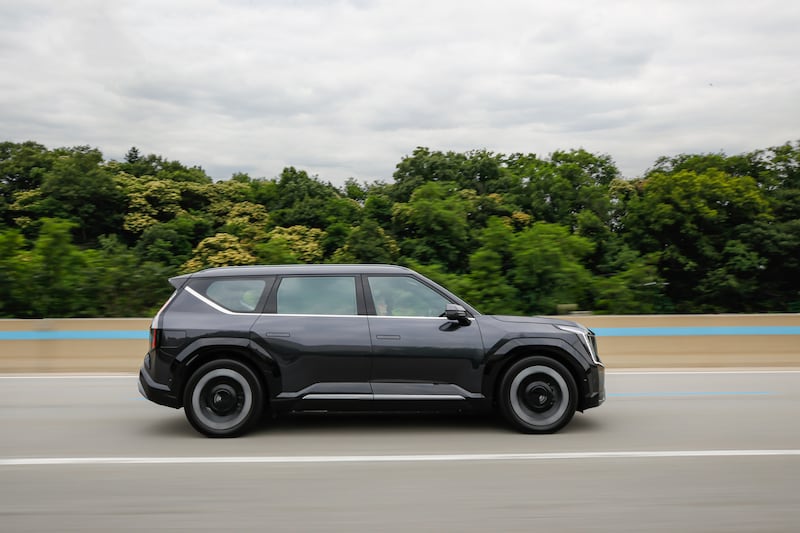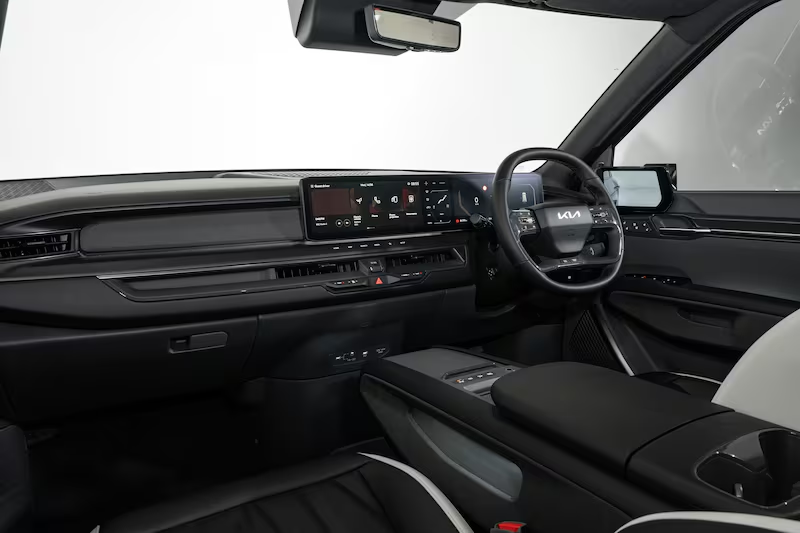It’s got seven seats, it’s an SUV and it’s an EV. That should be enough boxes ticked for many well-heeled Irish families.
A starting price of €77,500 will prove the biggest hurdle to this Kia’s success. Yet to judge this sum against the money being spent on new cars at present, there should be a strong enough cohort of buyers to send EV9 sales firmly into high three-figure registration numbers next year.
Kia has come a remarkably long way in a very short time, thanks to a mix of serious model improvements and a greater open-mindedness among car buyers. Where once the brand positions were cast in stone, it’s far more fluid these days, with newcomers establishing a foothold in a matter of months.
For Kia, it has meant that buyers will not baulk at paying €80,000 for a Korean car.
Summer 2025: 100 great restaurants, cafes and places to eat around Ireland
Housewife of the Year review: A reminder that Ireland of the 1970s and 80s was no country for women of any age
‘There’s a menace, an edge to life in America that wasn’t there before. And the possibility of dark stuff’
Netflix, Prime Video, Disney+, Apple TV+: 10 of the best new shows to stream in June
The styling is the biggest talking point, something of an homage to Land Rover design maestro Gerry McGovern, who incidentally has Leitrim roots. It’s dramatic in the photos, less so in the metal as it’s lower to the ground than some might expect from such a big, boxy SUV. The back is a block of sheet metal, but the front is admirably futuristic. It’s a bold statement that indicates a brave and confident brand.
As the follow-up to the sleek EV6, it’s clear that Kia’s management has great faith in its design team. And rightly so.
It’s not just the bold aesthetics that Kia’s new EVs share, but this car is built largely on the EV6′s underpinnings as well.
[ Kia EV9: All-electric seven-seat SUV with Range Rover pretentionsOpens in new window ]
Two versions are on offer here: a rear-driven single motor 200bhp version and a four-wheel-drive dual-motor set-up with 379bhp. All feature a 99.8kWh battery pack, which weighs in at 557kg and claims a range of up to 563km on a single charge.
Our test car was the all-wheel drive that claims 503km on a single charge and certainly packs the right level of torque for wet and muddy country roads, with a claimed 0-100km/h of 5.3 seconds, which is faster than a regular EV6. It’s probably as quick as you’ll want to go in a 2.4-tonne SUV loaded with six of your nearest and dearest relatives. The single motor version claims a more sedate 9.4 seconds.

While Kia claims an official consumption rate of 22.8 kWh/100km for the dual-motor version, during a series of earlier testing sessions behind the wheel, we achieved figures of 19.6kWh/100km in urban driving, but our average on regular country roads was 30.4kWh/100km, which equates to closer to 350km on a full charge.
It also comes with the choice of either six or seven seats in the upper grade GT-line version, priced for both seating formats at €88,500.
For my money, I’d opt for seven seats, both to secure a wider resale market and because I found the adjustment of the middle row “captain’s chairs” very fiddly and awkward. How often are you really going to turn those seats around over the average year?
[ Kia targets premium buyers with new all-electric seven-seaterOpens in new window ]
To house the big battery pack, the EV9 has a long floorpan, longer than a Land Rover Discovery, for example. The great boon of that long floorpan is the ample legroom it offers to all three rows, plus enough bootspace to carry luggage or prams even with seven seats in action. Legroom is tightest for the third-row occupants, but they aren’t just an afterthought, getting cupholders and USBs even back there.
The EV9 interior is also remarkably quiet. For such a big lump of metal, it achieves cabin noise figures that are close to the much-praised BMW iX.

For all the praise, I have a few caveats about the EV9.
The first is its driving dynamics. Of course, you need to disengage quite a few driver “assistance” systems before you can even judge the EV9 on its own merits. Like all new cars launched this year, the mandatory alerts which come to life every time you switch on the car mean that you need to undergo a routine of reducing or disengaging their sensitivity, or else you spend your time fighting the car’s central computer for control of the steering wheel to the soundtrack of a cacophony of beeps and bongs.
These are all fitted to save lives and are very worthy and earnest, but they make it difficult to get a feel of how a car actually handles and drives. When we did manage to disengage the most intrusive ones, the end product wasn’t on a par with the pleasures of its sibling, the EV6.
It’s certainly quick and has the straight-line thrust to hurl you towards the horizon that we’ve come to expect from EVs. However, the chassis is not that refined. It bounces a little too much on your typical rural road, while also wallowing a little in the corners. Even allowing for the fact this is a much longer, taller and heavier car than the EV6, it has retained little of the engaging drive we so liked about Kia’s earlier EV. There just isn’t the level of steering feel to make it a fun drive.
Another qualm is the quality of some of the interior. Certainly, it’s smartly laid out and functional. It doesn’t take long to figure out the menus, nor is the multiple steering controls beyond the bounds of average intelligence. However, in too many areas the hard plastics are not on a par with the €80,000 price tag. If you are playing at this level then you need to offer a sharper, more sophisticated finish. It’s the little things that matter.
[ Will an EV end up costing more or less than a petrol or diesel car?Opens in new window ]
My final issue would be to point to the Sorento, the EV9′s seven-seat sibling that’s offered in PHEV format. It’s smart, spacious, roomy and nice to drive, plus it offers the mix of 50km of full electric driving before turning to the petrol engine. It’s nowhere near as quick as the EV9, but it just feels more engaging behind the wheel. It’s also packed with all the gizmos you’ll ever need. And it’s at least €17,000 cheaper. A facelifted version of Sorento will land next year, but we’re led to believe the pricing gap between it and the EV9 will still be substantial.
Clearly the EV9 propels Kia into the new age of motoring while the Sorento clings to the past. But for families in more remote locations (those not living in the leafy suburbs within 5km of the school) where the public charging network is still in its infancy, then the PHEV may be the more viable alternative right now. It’s certainly better value.
For the rest, the EV9 is a spacious, premium car choice, but with a price to match.
Lowdown: Kia EV9 GT-Line
Power: Dual-motor all-wheel-drive set-up putting out 379bhp and 700Nm of torque
CO2 emissions (annual motor tax): 0g/km (€120)
Electric consumption: 22.8 kWh/100km (WLTP)
Electric range: 503km (WLTP) (563km for single motor version)
0-100km/h: 5.3 sec (9.4 secs for single motor)
Price: €88,500 as tested (starts at €77,500 for Earth single motor version)
Our rating: 3/5
Our verdict: Stylish and spacious EV that doesn’t quite deliver for driving fun or premium finish









